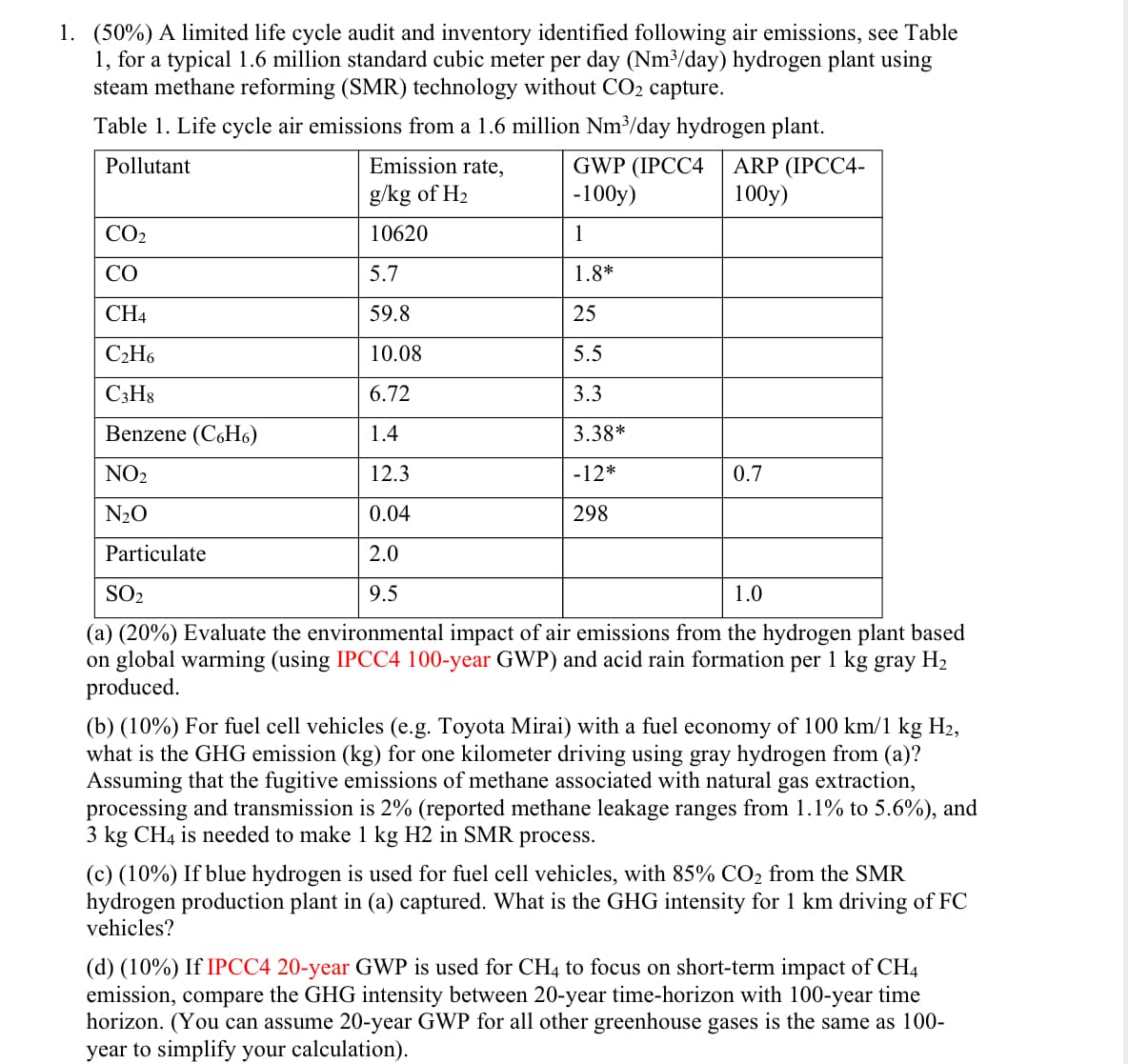CO 5.7 1.8* CH4 59.8 25 C2H6 10.08 5.5 C3H8 6.72 3.3 Benzene (C6H6) 1.4 3.38* NO2 12.3 -12* 0.7 N₂O 0.04 298 Particulate 2.0 SO2 9.5 1.0 (a) (20%) Evaluate the environmental impact of air emissions from the hydrogen plant based on global warming (using IPCC4 100-year GWP) and acid rain formation per 1 kg gray H₂ produced. (b) (10%) For fuel cell vehicles (e.g. Toyota Mirai) with a fuel economy of 100 km/1 kg H2, what is the GHG emission (kg) for one kilometer driving using gray hydrogen from (a)? Assuming that the fugitive emissions of methane associated with natural gas extraction, processing and transmission is 2% (reported methane leakage ranges from 1.1% to 5.6%), and 3 kg CH4 is needed to make 1 kg H2 in SMR process. (c) (10%) If blue hydrogen is used for fuel cell vehicles, with 85% CO₂ from the SMR hydrogen production plant in (a) captured. What is the GHG intensity for 1 km driving of FC vehicles? (d) (10%) If IPCC4 20-year GWP is used for CH4 to focus on short-term impact of CH4
CO 5.7 1.8* CH4 59.8 25 C2H6 10.08 5.5 C3H8 6.72 3.3 Benzene (C6H6) 1.4 3.38* NO2 12.3 -12* 0.7 N₂O 0.04 298 Particulate 2.0 SO2 9.5 1.0 (a) (20%) Evaluate the environmental impact of air emissions from the hydrogen plant based on global warming (using IPCC4 100-year GWP) and acid rain formation per 1 kg gray H₂ produced. (b) (10%) For fuel cell vehicles (e.g. Toyota Mirai) with a fuel economy of 100 km/1 kg H2, what is the GHG emission (kg) for one kilometer driving using gray hydrogen from (a)? Assuming that the fugitive emissions of methane associated with natural gas extraction, processing and transmission is 2% (reported methane leakage ranges from 1.1% to 5.6%), and 3 kg CH4 is needed to make 1 kg H2 in SMR process. (c) (10%) If blue hydrogen is used for fuel cell vehicles, with 85% CO₂ from the SMR hydrogen production plant in (a) captured. What is the GHG intensity for 1 km driving of FC vehicles? (d) (10%) If IPCC4 20-year GWP is used for CH4 to focus on short-term impact of CH4
Applications and Investigations in Earth Science (9th Edition)
9th Edition
ISBN:9780134746241
Author:Edward J. Tarbuck, Frederick K. Lutgens, Dennis G. Tasa
Publisher:Edward J. Tarbuck, Frederick K. Lutgens, Dennis G. Tasa
Chapter1: The Study Of Minerals
Section: Chapter Questions
Problem 1LR
Related questions
Question

Transcribed Image Text:1. (50%) A limited life cycle audit and inventory identified following air emissions, see Table
1, for a typical 1.6 million standard cubic meter per day (Nm³/day) hydrogen plant using
steam methane reforming (SMR) technology without CO2 capture.
Table 1. Life cycle air emissions from a 1.6 million Nm³/day hydrogen plant.
Pollutant
Emission rate,
g/kg of H2
GWP (IPCC4
-100y)
ARP (IPCC4-
100y)
CO2
10620
1
CO
5.7
1.8*
CH4
59.8
25
C2H6
10.08
5.5
C3H8
6.72
3.3
Benzene (C6H6)
1.4
3.38*
NO2
12.3
-12*
0.7
N₂O
0.04
298
Particulate
2.0
SO2
9.5
1.0
(a) (20%) Evaluate the environmental impact of air emissions from the hydrogen plant based
on global warming (using IPCC4 100-year GWP) and acid rain formation per 1 kg gray H₂
produced.
(b) (10%) For fuel cell vehicles (e.g. Toyota Mirai) with a fuel economy of 100 km/1 kg H2,
what is the GHG emission (kg) for one kilometer driving using gray hydrogen from (a)?
Assuming that the fugitive emissions of methane associated with natural gas extraction,
processing and transmission is 2% (reported methane leakage ranges from 1.1% to 5.6%), and
3 kg CH4 is needed to make 1 kg H2 in SMR process.
(c) (10%) If blue hydrogen is used for fuel cell vehicles, with 85% CO2 from the SMR
hydrogen production plant in (a) captured. What is the GHG intensity for 1 km driving of FC
vehicles?
(d) (10%) If IPCC4 20-year GWP is used for CH4 to focus on short-term impact of CH4
emission, compare the GHG intensity between 20-year time-horizon with 100-year time
horizon. (You can assume 20-year GWP for all other greenhouse gases is the same as 100-
year to simplify your calculation).
Expert Solution
This question has been solved!
Explore an expertly crafted, step-by-step solution for a thorough understanding of key concepts.
Step by step
Solved in 6 steps

Recommended textbooks for you

Applications and Investigations in Earth Science …
Earth Science
ISBN:
9780134746241
Author:
Edward J. Tarbuck, Frederick K. Lutgens, Dennis G. Tasa
Publisher:
PEARSON

Exercises for Weather & Climate (9th Edition)
Earth Science
ISBN:
9780134041360
Author:
Greg Carbone
Publisher:
PEARSON

Environmental Science
Earth Science
ISBN:
9781260153125
Author:
William P Cunningham Prof., Mary Ann Cunningham Professor
Publisher:
McGraw-Hill Education

Applications and Investigations in Earth Science …
Earth Science
ISBN:
9780134746241
Author:
Edward J. Tarbuck, Frederick K. Lutgens, Dennis G. Tasa
Publisher:
PEARSON

Exercises for Weather & Climate (9th Edition)
Earth Science
ISBN:
9780134041360
Author:
Greg Carbone
Publisher:
PEARSON

Environmental Science
Earth Science
ISBN:
9781260153125
Author:
William P Cunningham Prof., Mary Ann Cunningham Professor
Publisher:
McGraw-Hill Education

Earth Science (15th Edition)
Earth Science
ISBN:
9780134543536
Author:
Edward J. Tarbuck, Frederick K. Lutgens, Dennis G. Tasa
Publisher:
PEARSON

Environmental Science (MindTap Course List)
Earth Science
ISBN:
9781337569613
Author:
G. Tyler Miller, Scott Spoolman
Publisher:
Cengage Learning

Physical Geology
Earth Science
ISBN:
9781259916823
Author:
Plummer, Charles C., CARLSON, Diane H., Hammersley, Lisa
Publisher:
Mcgraw-hill Education,